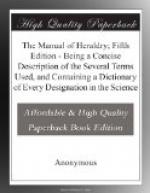[Illustration: Radient]
If a shield is divided into four equal parts, it is said to be quartered: this may be done two ways, viz.—
[Illustration: Quartered per cross]
QUARTERED PER CROSS—The shield is divided into four parts, called quarters, by an horizontal and perpendicular line, crossing each other in the centre of the field, each of which is numbered.
[Illustration: Quartered per Saltier]
QUARTERED PER SALTIER, which is made by two diagonal lines, dexter and sinister, crossing each other in the centre of the field.
[Illustration: Quarterings]
The Escutcheon is sometimes divided into a great number of parts, in order to place in it the arms of several families to which one is allied; this is called a genealogical achievement. The compartments are called QUARTERINGS.
DIFFERENCES.
All members of the same family claim the same bearings in their coat of arms; and to distinguish the principal bearer from his descendants or relatives, it was necessary to invent some sign, so that the degree of consanguinity might be known. These signs are called DIFFERENCES. During the Crusades the only difference consisted in the bordure or border, which, as the name implies, was a border or edging running round the edge of the shield. The colour and form of this border served to distinguish the leaders of the different bands that served under one duke or chieftain. The same difference might be used to denote a diversity between particular persons descended from one family. At the present time they are not used to denote a difference, but as one of the ordinaries to a coat of arms. The annexed example exhibits the arms of the Monastery of Bermondsey. Party per pale, azure and gules; a bordure, argent. This bordure is plain; but they may be formed by any of the foregoing lines.
[Illustration: Monastery of Bermondsey arms.]
[Illustration: or, a bordure engrailed, gules]
The annexed example is or, a bordure engrailed, gules.
The differences used by armorists at the present time are nine in number. They not only distinguish the sons of one family, but also denote the subordinate degrees in each house.
The Heir, or first son, the LABEL
[Illustration: Label]
Second Son, the CRESCENT
[Illustration: Crescent]
Third Son, the MULLET
[Illustration: Mullet]
Fourth Son, the MARTLET
[Illustration: Martlet]
Fifth Son, the ANNULET
[Illustration: Annulet]
Sixth Son, the FLEUR-DE-LIS
[Illustration: Fleur-de-Lis]
Seventh Son, the ROSE
[Illustration: Rose]
Eighth Son, the CROSS MOLINE
[Illustration: Cross Moline]
Ninth Son, the DOUBLE QUATREFOIL




